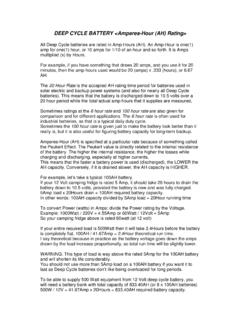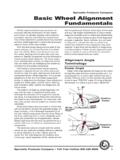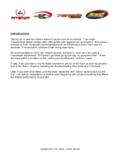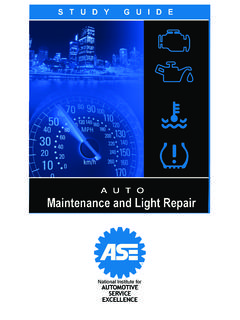Transcription of Basic Wheel Alignment Techniques - Crypton
1 1 Basic Wheel Alignment Techniques MASTERING THE basics : Modern steering and suspension systems are great examples of solid geometry at work. Wheel Alignment integrates all the factors of steering and suspension geometry to provide safe handling, good ride quality and maximum tire life. front Wheel Alignment is described in terms of angles formed by steering and suspension components. Traditionally, five Alignment angles are checked at the front wheels-- caster , camber, toe, steering axis inclination (SAI) and toe-out on turns. When we move from two- Wheel to four- Wheel Alignment , we add setback and the vehicle thrust angle into the equation.
2 Rear Wheel camber and toe also must be checked for a four- Wheel Alignment . Tire Wear & Directional Control Camber, toe and toe-out on turns are tire-wear angles. If they're incorrect, the tires will wear unevenly and faster than normal. Because camber is related to steering axis inclination, SAI also can be considered a tire-wearing angle. caster and setback are not tire-wear angles unless extremely out of specification. All Alignment angles are directional control angles, which means they affect steering and vehicle control. Troubleshooting a complaint about vehicle handling, ride or vibration starts with knowing what a particular Alignment angle does and how all the angles work together.
3 Before you plunge into system diagnosis, take a moment to think about the system operating principles. Therefore, let's review these Basic Alignment angles with an eye toward typical complaints and troubleshooting. caster : caster is the tilt of the steering axis of each front Wheel as viewed from the side of the vehicle. caster is measured in degrees of an angle. If the steering axis tilts backward-that is, the upper ball joint or strut mounting point is behind the lower ball joint-the caster angle is positive. If the steering axis tilts forward, the caster angle is negative. caster is not measured for rear wheels.
4 2 caster affects straightline stability and steering Wheel return. High positive caster makes the front wheels want to go straight ahead. A normal amount of positive caster provides stability and makes the steering Wheel straighten out after turning. On the other hand, positive caster increases the effort needed to turn the Wheel . Power steering allows the use of more positive caster than would be acceptable with manual steering. Too little caster can make steering unstable and cause Wheel shimmy. Extremely negative caster and the related shimmy can contribute to cupped wear of the front tires. If caster is unequal from side to side, the vehicle will pull toward the side with less positive (or more negative) caster .
5 Remember this when troubleshooting a complaint of vehicle pull or wander. Camber: Camber is the tilt of the Wheel from true vertical as viewed from the front of the vehicle. Like caster , camber is measured in degrees of an angle. If the tire appears to tilt outward at the top, the camber angle is positive. If the top of the tire tilts inward, the camber angle is negative. Zero camber-a perfectly vertical Wheel and tire-causes the least tire wear. Positive camber causes the outer tread of the tire to wear more than the inner tread; negative camber has the opposite effect. Engineers design small amounts of positive or negative camber into vehicle suspensions to aid handling and steering.
6 Normal camber angles have little visible effect on tire wear, but extreme camber causes noticeably abnormal tire wear and shortens tire life. Positive camber, like positive caster , affects straight-ahead stability and steering Wheel return. As the vehicle turns, the outside suspension tends to rise on the Wheel because of positive camber. When the Wheel returns to straight ahead, the vehicle's weight presses down on the steering axis and helps straighten the Wheel . Negative camber resists the tendency of the tire to slip sideways during cornering. It also can increase steering effort. Most cars and light trucks are designed with positive camber, but many race cars and some high-performance street vehicles have negative camber.
7 Rear wheels usually have zero camber, but some independent rear suspensions are designed with some amount of (usually negative) camber angle. If front camber angles 3 are unequal side to side, the vehicle pulls toward the side with the greater positive camber. Unequal rear camber also can affect vehicle handling. Toe: Toe is how the wheels are aimed, as viewed from above. A pair of front or rear wheels aimed inward at the forward edges have toe-in; wheels aimed outward have toe-out. The toe angle for front or rear wheels is measured in fractions of an inch, millimeters or fractions of a degree. Zero toe-wheels aimed straight ahead-causes the least tire wear.
8 Extreme toe-in or toe-out causes feather-- edged wear across the tire tread. Too much toe-in wears the outside tread edges, with feathered edges on the inside of each tread row. Too much toe-- out has the opposite effect. front wheels are usually toed in on rear-drive vehicles and toed out on front -drives to compensate for changes in the steering linkage and tires when the vehicle is moving. When the vehicle is moving, toe decreases (or disappears) because the wheels straighten out under acceleration and the steering linkage flexes slightly. Toe change, or bump steer, occurs when a steering tie rod is the wrong length or is installed at the wrong angle.
9 The outer tie-rod end moves up and down as the suspension compresses and extends. If tie-rod length or angle is incorrect, it pulls or pushes the steering arm and aims the Wheel in a new direction, The driver feels this when the steering Wheel jerks to one side as the car goes over a bump or dip. Too-Out on Turns: Toe-out on turns also is called turning radius, or the Ackerman angle. As a vehicle turns, the outside front Wheel turns at a lesser angle than the inside Wheel . This causes the front tires to toe out during cornering. Some amount of toe-out on turns is necessary because the outside Wheel must turn on a larger radius than the inside Wheel .
10 If Wheel turning angles were equal, the outside tire would scuff as it tried to turn on a shorter radius. Toe-out on turns is designed into a vehicle's steering geometry and must be equal in both right and left directions. Toe-out on turns is not adjustable. Angles that are unequal from side to side or out of specification are caused by vehicle damage. 4 Steering Axis Inclination: Steering axis inclination (SAI) is the tilt of the steering axis from vertical as viewed from the front . It's an angle formed by a line through the centers of the lower and upper ball joints of the strut mount. Like caster , SAI affects steering feel and stability In a suspension that doesn't have much caster , high SAI can provide solid steering feel and stability.






